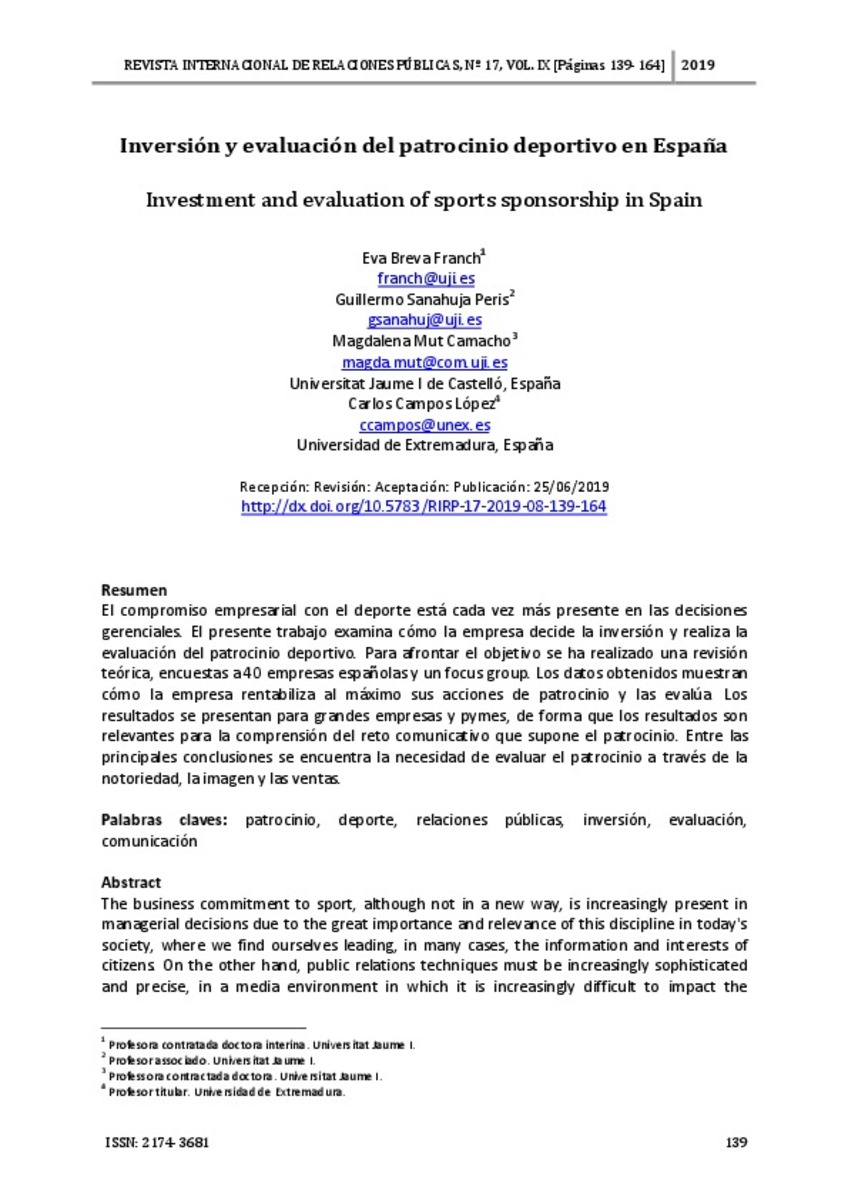Mostrar el registro sencillo del ítem
Inversión y evaluación del patrocinio deportivo en España
| dc.contributor.author | Breva-Franch, Eva | |
| dc.contributor.author | Sanahuja Peris, Guillermo | |
| dc.contributor.author | Mut-Camacho, Magdalena | |
| dc.contributor.author | Campos López, Carlos | |
| dc.date.accessioned | 2019-09-23T18:30:28Z | |
| dc.date.available | 2019-09-23T18:30:28Z | |
| dc.date.issued | 2019 | |
| dc.identifier.citation | BREVA FRANCH, Eva, et al. Inversión y evaluación del patrocinio deportivo en España/Investment and evaluation of sports sponsorship in Spain. Revista Internacional de Relaciones Públicas, 2019, vol. 9, núm. 17, p. 139-164 | ca_CA |
| dc.identifier.issn | 2174-3681 | |
| dc.identifier.uri | http://hdl.handle.net/10234/183886 | |
| dc.description.abstract | El compromiso empresarial con el deporte está cada vez más presente en las decisiones gerenciales. El presente trabajo examina cómo la empresa decide la inversión y realiza la evaluación del patrocinio deportivo. Para afrontar el objetivo se ha realizado una revisión teórica, encuestas a 40 empresas españolas y un focus group. Los datos obtenidos muestran cómo la empresa rentabiliza al máximo sus acciones de patrocinio y las evalúa. Los resultados se presentan para grandes empresas y pymes, de forma que los resultados son relevantes para la comprensión del reto comunicativo que supone el patrocinio. Entre las principales conclusiones se encuentra la necesidad de evaluar el patrocinio a través de la notoriedad, la imagen y las ventas. | ca_CA |
| dc.description.abstract | The business commitment to sport, although not in a new way, is increasingly present in managerial decisions due to the great importance and relevance of this discipline in today's society, where we find ourselves leading, in many cases, the information and interests of citizens. On the other hand, public relations techniques must be increasingly sophisticated and precise, in a media environment in which it is increasingly difficult to impact the consumer in the search for their response and action. A consumer wanting to get involved in their environment and participate in companies, through their brands, which also echoes the responsibility of brands in their day to day and in the actions closest to them. Therefore, the present work examines how the company decides the investment in sponsorship and how it carries out the evaluation of sports sponsorship in its struggle to take responsibility actions that provide intangible values difficult to achieve with the only use of advertising campaigns to the use. In order to meet the objective set out in this paper, a theoretical review has been carried out from the company's perspective and what the application of different disciplines means to achieve its objectives, reviewing concepts such as the activation of sponsorship and the evaluation of sponsorship. lay the foundations for a practical investigation that offers an image of what is happening nowadays with companies and sports. The theoretical revision has served to carry out a fieldwork by applying two techniques in two different and consecutive phases; On the one hand, in the first phase a quantitative technique has been used, such as the completion of a survey with a structured questionnaire, sent to more than 100 companies selected according to objective criteria, obtaining a response from 40 Spanish companies that develop sponsorship actions Within their communication strategies, both large organizations and SMEs have been included in the selection of the sample, in view of the need to review whether they act in the same way although with different investments or their behavior changes to different needs. The second phase has had a more qualitative technique such as the realization of a focus group to a group of specialists in sponsorship and advertising techniques, as well as public relations, with the aim of assessing and validating or not, the quantitative results and to be able to draw general conclusions, this has been a convenience sample in which the experience and knowledge have been sought in order to deepen in the treated topic. The data obtained shows how the company maximizes its sponsorship actions and its evaluation actions. The results are presented broken down, considering the two types of companies with which they have worked; for large companies and SMEs, so that the information is relevant for understanding the communicative challenge of sponsorship, taking into account the type of company and its objectives. Among the main conclusions is the need to evaluate sponsorship through strategic measures such as notoriety, image and, of course, sales. | ca_CA |
| dc.format.extent | 26 p. | ca_CA |
| dc.format.mimetype | application/pdf | ca_CA |
| dc.language.iso | spa | ca_CA |
| dc.publisher | Universidad de Málaga (UMA): Instituto de Investigación en Relaciones Públicas | ca_CA |
| dc.relation.isPartOf | Revista Internacional de Relaciones Públicas, 2019, vol. 9, núm. 17, p. 139-164 | ca_CA |
| dc.rights | Este trabajo está licenciado bajo la licencia Creative Commons Attribution 4.0 | ca_CA |
| dc.rights | Atribución 4.0 Internacional | * |
| dc.rights.uri | http://creativecommons.org/licenses/by-sa/4.0/ | * |
| dc.subject | patrocinio | ca_CA |
| dc.subject | deporte | ca_CA |
| dc.subject | relaciones públicas | ca_CA |
| dc.subject | inversión | ca_CA |
| dc.subject | evaluación | ca_CA |
| dc.subject | comunicación | ca_CA |
| dc.subject | sponsorship | ca_CA |
| dc.subject | sports | ca_CA |
| dc.subject | public relations | ca_CA |
| dc.subject | investment | ca_CA |
| dc.subject | evaluation | ca_CA |
| dc.subject | communication | ca_CA |
| dc.title | Inversión y evaluación del patrocinio deportivo en España | ca_CA |
| dc.title.alternative | Investment and evaluation of sports sponsorship in Spain | ca_CA |
| dc.type | info:eu-repo/semantics/article | ca_CA |
| dc.identifier.doi | http://dx.doi.org/10.5783/RIRP-17-2019-08-139-164 | |
| dc.rights.accessRights | info:eu-repo/semantics/openAccess | ca_CA |
| dc.relation.publisherVersion | http://revistarelacionespublicas.uma.es/index.php/revrrpp/article/view/581 | ca_CA |
| dc.type.version | info:eu-repo/semantics/publishedVersion | ca_CA |
Ficheros en el ítem
Este ítem aparece en la(s) siguiente(s) colección(ones)
-
COM_Articles [809]








